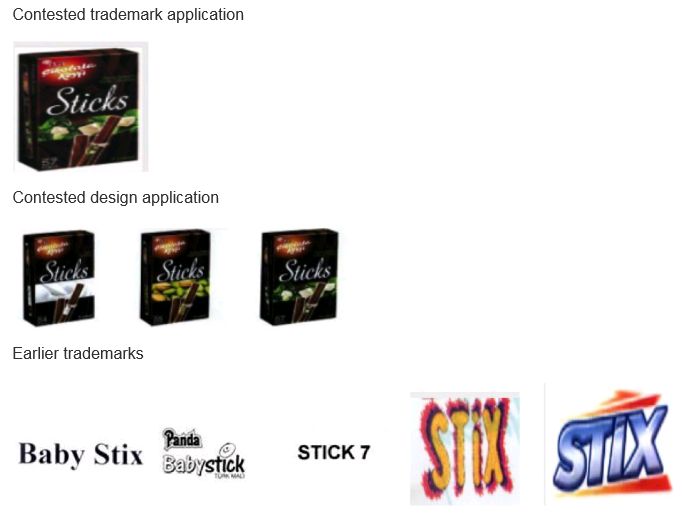- Owner of STICK and STIX marks opposed registration of figurative mark and design containing 'sticks'
- IP Courts found no likelihood of confusion and that 'stick' is descriptive
- Court of Appeal disagreed in somewhat unusual decision
In two recent decisions (Merit No 2016/2525, Decision No
2017/4913, dated October 2 2017; and Merit No 2016/2484, Decision
No 2017/4777, dated September 27 2017), the 11th Chamber of the
Court of Appeal has dismissed decisions of the first instance
courts (Ankara Fourth Civil IP Court, Merit No 2014/295, Decision
No 2015/47, dated March 30 2015; and Ankara First Civil IP Court,
Merit No 2013/158, Decision No 2014/94, dated March 27 2014),
declaring
that the words 'stick' and 'stix' were the main and most prominent elements of the plaintiff's earlier trademarks and that they were distinctive.
Facts
The defendant company applied to register the signs depicted below as a trademark and design:

Following the publication of the applications, oppositions were filed based on earlier registrations for STICK, STICK 7, BABY STIX, PANDA BABY STICK TÜRK MALI and STIX, registered for goods in Class 30. The Turkish Patent and Trademark Office rejected both oppositions, since it was of the opinion that there was no likelihood of confusion between the applications and the earlier trademarks. The plaintiff appealed these decisions, but the appeals were rejected by the Re-examination and Evaluation Board of the office.
Consequently, the owner of the earlier trademarks filed lawsuits, seeking the cancellation of the office's decisions and the invalidation of the trademark and design at issue.
Decision
The Ankara Fourth Civil IP Court rejected the action, declaring that the contested trademark includes the well-known trademark ETI and that the parties' trademarks were not confusingly similar for the average consumers. The Ankara First Civil IP Court also rejected the action filed against the design, stating that the expression 'stick' has a meaning in Turkish and is widely used in Turkey; therefore, this common expression is descriptive.
On appeal, the Court of Appeal dismissed both first instance decisions on similar grounds:
- The words 'stick' and 'stix' were the main and most prominent elements of the earlier trademarks. Therefore, it was not possible to consider that these words were secondary or descriptive elements with regard to the goods falling within the scope of protection of the trademarks.
- The applications combined device and verbal elements, and the expression 'sticks' stood out. Consequently, consumers might be misled as to the origin of the goods and consider that there was an administrative or economic link between the trademarks/design.
The first instance courts abided with the Court of Appeal's decision, and the trademark and design at issue were cancelled at the end of the proceedings.
Comment
The IP Courts and the Court of Appeal reached different conclusions based on different reasonings. While the Ankara Fourth IP Court stated that the contested trademark includes the well-known trademark ETI and that the parties' trademarks are not confusingly similar for the average consumers, the Court of Appeal stated that the applications were similar to, and created a likelihood of confusion with, the plaintiff's word marks STICK, STICK 7, BABY STIX, PANDA BABY STICK TÜRK MALI and STIX. Arguably, the findings of the Court of Appeal are somehow uncommon and significant for trademark law, as the applications were found to be similar to the earlier word marks even though the applications consisted of both device and verbal elements.
Moreover, while the Ankara First Civil IP Court stated that the expression 'stick' has a meaning in Turkish, is widely used in Turkey and is thus descriptive, these findings were not found to be appropriate by the Court of Appeal. Although 'stick' is a common word with a general meaning referring to, for example, an ice cream stick, the Court of Appeal, interestingly, found that the words 'stick' and 'stix' were the main and most prominent elements of the earlier trademarks and that they were distinctive.
Consequently, the IP Courts and the Court of Appeal's assessments as to the likelihood of confusion between trademarks containing a generic word were quite different. However, the Court of Appeal approved the IP Courts' abidance decisions on September 27 2017 and October 2 2017 and, therefore, shed light on its legal position on trademarks containing generic words. It remains to be seen how this decision will affect Turkish trademark law practice and whether the Patent and Trademark Office will rely on it in future decisions.
First published by WTR, in 29.03.2018
The content of this article is intended to provide a general guide to the subject matter. Specialist advice should be sought about your specific circumstances.


